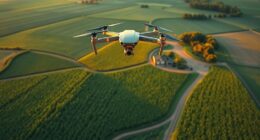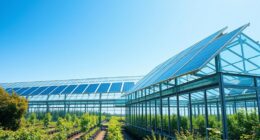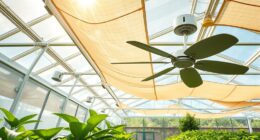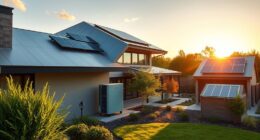When considering wind turbines for rooftops, remember key factors: wind speed affects power, larger turbines capture more energy, maintenance is essential. Challenges include vibration, turbulence, and costs. Economically, consider payback periods, savings, and long-term benefits. Innovative designs like IMPLUX and Ventum enhance efficiency. To optimize power output, placement is key—higher elevations reduce turbulence. Future outlook promises sustainable urban energy solutions. Explore more about rooftop wind turbines to make informed decisions.
Key Takeaways
- Rooftop turbines face challenges like vibration and turbulence.
- Turbine size impacts efficiency and power output.
- Innovative designs like shrouded turbines enhance performance.
- Proper placement and maintenance are vital for optimal power generation.
- Economic considerations include installation costs and long-term benefits.
Wind Turbine Efficiency Factors
Factors influencing the effectiveness of rooftop wind turbines include wind speed, turbine size, and design features. When it comes to small wind turbines mounted on rooftops, wind speed plays a vital role in determining their power output and overall energy production. Higher wind speeds result in increased effectiveness, allowing the turbines to generate more electricity.
Additionally, turbine size directly impacts effectiveness, with larger turbines capturing more wind energy due to their larger rotor diameters. Innovative design features such as shrouds or ducts can further enhance turbine effectiveness by concentrating and accelerating airflow towards the blades, maximizing energy production.
Therefore, to consider prime performance of rooftop wind turbines, it's essential to take into account these key factors. By selecting the right turbine size, designing efficient airflow-enhancing features, and placing the turbines in locations with high wind speeds, you can greatly enhance turbine effectiveness and overall energy output.
Regular maintenance and proper placement are also important for maintaining high effectiveness levels in rooftop wind turbines.
Rooftop Wind Turbine Challenges

When considering rooftop wind turbines, it's crucial to acknowledge the challenges they face, including issues such as vibration and noise due to their unique installation location. Rooftop turbines are subjected to increased turbulence which can impact their efficiency and longevity. The engineering constraints of rooftop installations make them less cost-effective compared to ground-based systems.
Vibration and noise are prominent challenges for rooftop turbines, affecting both the performance and acceptability of these installations in urban settings. The turbulence experienced on rooftops further exacerbates these issues, reducing the efficiency of the turbines over time.
Despite these challenges, rooftop wind turbines play a pivotal role in integrating renewable energy sources into urban environments. To tackle the engineering constraints associated with rooftop installations, innovative solutions are being developed to optimize the performance and mitigate the challenges faced by these systems.
Economic Considerations for Rooftop Turbines
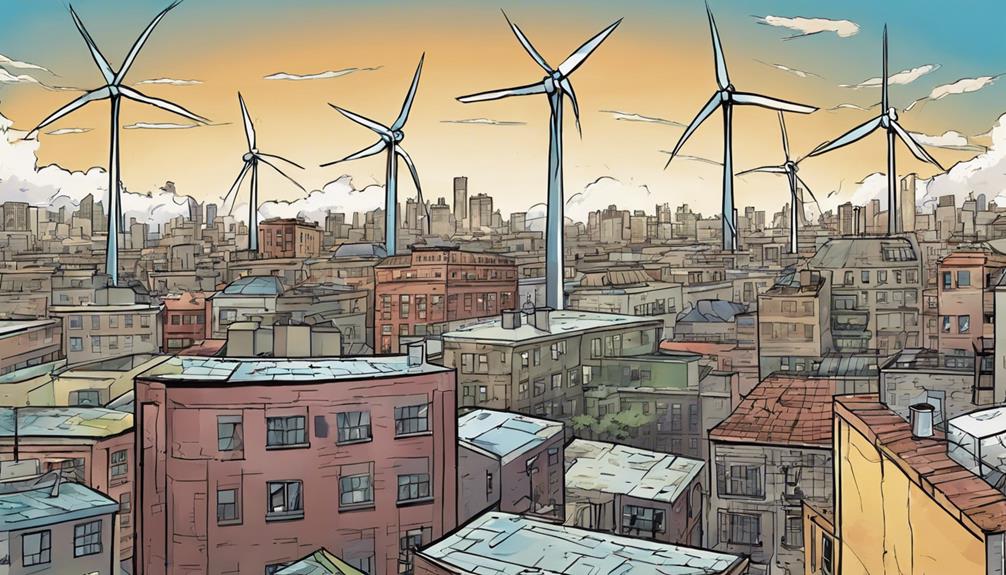
Considering the economic challenges associated with rooftop wind turbines, their installation costs and space limitations pose significant obstacles to their widespread adoption. Rooftop wind turbines can range in cost from a few thousand to tens of thousands of dollars, with payback periods varying from several years to over a decade.
When evaluating the economic feasibility of rooftop turbines, it's important to take into account maintenance costs, installation expenses, and potential energy savings. These factors play an essential role in determining whether investing in rooftop wind power aligns with your financial goals.
Despite the initial hurdles, rooftop wind turbines offer long-term benefits such as energy independence and sustainability. By harnessing wind power on your rooftop, you can reduce your reliance on traditional energy sources and contribute to a greener environment.
While the economic considerations may seem challenging at first, the potential for long-lasting positive impacts on both your finances and the planet make rooftop wind turbines a compelling option for those looking to embrace renewable energy solutions.
Innovative Turbine Designs
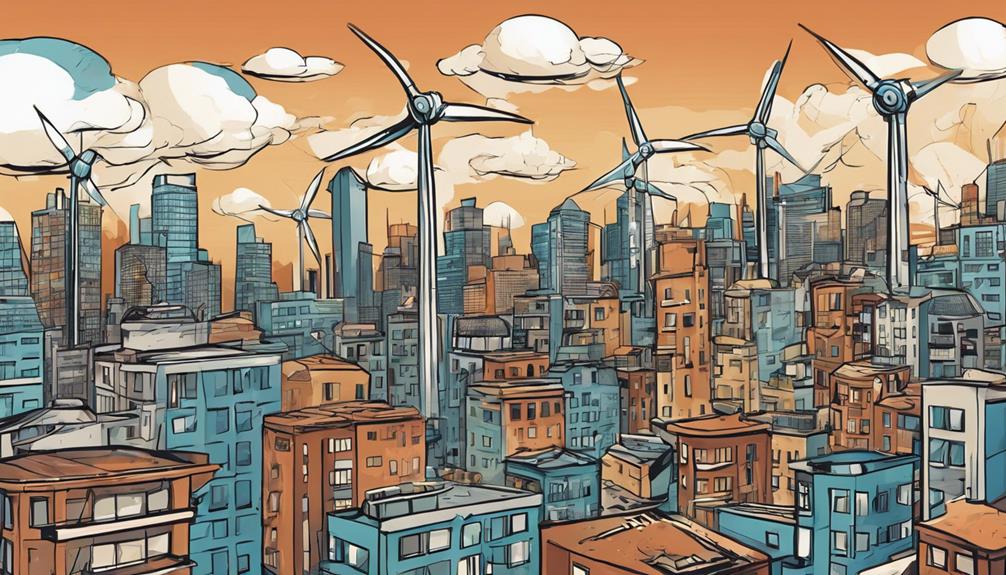
Innovative turbine designs in the field of wind energy technology showcase advancements aimed at maximizing power extraction efficiency and optimizing performance through various engineering approaches.
Vertical axis turbines like IMPLUX combine static and dynamic elements to enhance efficiency, while Ventum turbines focus on air capture to prevent leakage and boost performance.
Shrouded turbines such as the VX175 concentrate wind energy to increase power output significantly. Historical designs like Darwin's windmill utilized flaps, but contemporary turbines prioritize shrouds for improved efficiency.
Studies suggest that shrouds have the potential to amplify power output by 2 to 5 times, highlighting their impact on renewable energy generation.
Integrating these innovative turbine designs with rooftop solar systems can provide a sustainable solution for harnessing wind energy efficiently, especially as wind speed increases.
Embracing these advancements in turbine technology can enhance the performance of rooftop wind turbines and contribute to a more sustainable energy landscape.
Wind Turbine Power Output

Enhancing wind turbine power output hinges heavily on optimizing wind speed conditions and minimizing obstacles that can impede performance.
The power output of rooftop turbines, typically ranging from 400W to 1kW, is greatly affected by wind speeds. Turbines require a minimum wind speed, known as the cut-in speed, to start generating power. However, reaching their maximum power output is rare, as it occurs within a narrow range of wind speeds.
Rooftop installations face challenges due to turbulence and obstacles that can impact power output. These turbines usually begin producing power at wind speeds of 3.6 m/s or higher, with output varying based on wind conditions.
To be cost-effective, turbines need sustained winds. Hence, proper turbine construction and placement are essential to optimize power output and make rooftop installations economically viable.
Wind Turbine Placement Considerations

Optimizing wind turbine placement on rooftops necessitates strategic consideration of surrounding obstacles and wind dynamics to maximize power output efficiency.
When situating rooftop wind turbines, it's essential to make sure they're at least 30 feet higher than any nearby obstructions within a 500-foot radius. This elevation helps minimize turbulence, which tends to be more pronounced along the edges of rooftops, impacting both power output and the turbine's lifespan.
Engineers face challenges in designing these turbines due to the limitations imposed by proximity to the ground, which restricts blade size and affects overall performance. Additionally, factors like friction, wind shear, and thermal effects from the mounting location further influence power output.
Thus, to overcome these engineering hurdles and optimize power generation, rooftop wind turbine placement must carefully balance wind exposure, obstacle avoidance, and turbulence reduction.
Future of Rooftop Wind Turbines
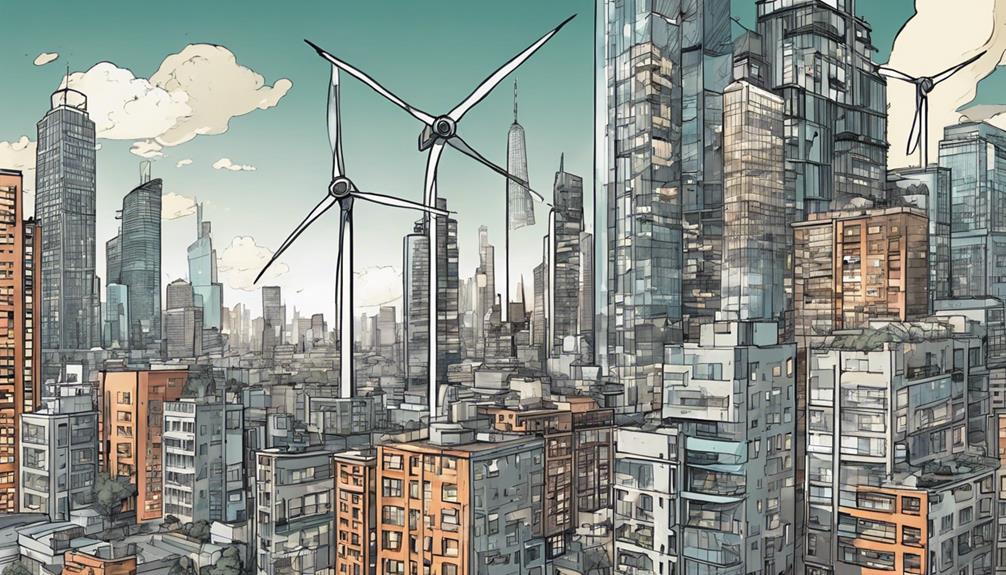
Looking ahead, the future of rooftop wind turbines in urban environments shows great promise for sustainable energy solutions. These compact turbines offer on-site renewable energy generation, reducing the reliance on traditional power sources.
Designed to fit into existing urban landscapes, rooftop wind turbines contribute to sustainability by minimizing the need for large land areas typically required for conventional wind farms. Technological advancements in rooftop wind turbine design aim to enhance energy production and efficiency, making them a viable option for urban settings.
The future of rooftop wind turbines involves innovative solutions to address challenges such as turbulence and noise in densely populated areas. By focusing on enhancing energy independence and reducing carbon footprints, these turbines are set to play a significant role in the renewable energy landscape.
With a growing emphasis on sustainable practices, integrating rooftop wind turbines into urban environments offers a practical way to promote renewable energy generation and contribute to a more environmentally friendly future.
Frequently Asked Questions
Are Rooftop Wind Turbines Worth It?
Are rooftop wind turbines worth it? Yes, they are a sustainable energy option with low wind speed capabilities. LED indicators show power generation, monitoring devices track output, and safety features like stop switches and cut-off switches enhance efficiency and convenience.
What Do You Need to Know About Wind Turbines?
Hey, curious about wind turbines? You should know they start at 7-10 mph, with LED indicators signaling power. Monitoring tracks output, and cut-off switches manage operation. Mounted at 6 feet, they perform from 7-25 mph.
Can I Put a Wind Turbine on My Roof?
You can put a wind turbine on your roof, but consider factors like wind speed and obstacles. Innovations are improving efficiency. Specific models like Air-X and Mallard are designed for rooftops, offering renewable energy solutions.
Are Roof Wind Turbines Efficient?
Are roof wind turbines efficient? They can be, especially with advancements in design and placement. Efficiency levels vary from 10% to 40% based on factors like location and turbine design. Consider these variables when considering rooftop wind turbines.
What Materials Are Used to Make Rooftop Wind Turbines?
Rooftop wind turbines are typically made using lightweight and durable materials for wind turbines such as aluminum, fiberglass, and carbon fiber. These materials allow the turbines to withstand the elements while also being easily installed on rooftops. Additionally, the use of these materials also ensures that the turbines are efficient and long-lasting.
How can Wind Turbines on Rooftops Contribute to Renewable Energy?
Installing wind turbines on rooftops is a smart way to generate renewable energy. By harnessing the power of the wind, these turbines can contribute to the overall renewable energy essentials: understanding basics. This helps reduce reliance on traditional energy sources and move towards a more sustainable future.
What Are the Latest Advances in Wind Turbine Technology for Rooftop Use?
The latest advances in wind energy technology have led to innovative solutions for rooftop wind turbines. With improvements in design and materials, smaller and more efficient turbines can now be installed on urban rooftops, providing clean energy in areas with limited space for traditional wind farms.
Conclusion
You've learned about the potential of rooftop wind turbines, but did you know that a single turbine can generate enough energy to power a home for a year? Imagine the savings and environmental impact that could have on your community.
With advancements in efficiency and design, rooftop wind turbines have the potential to revolutionize sustainable energy solutions for urban areas. Keep an eye out for these innovative technologies as they continue to grow in popularity and effectiveness.







